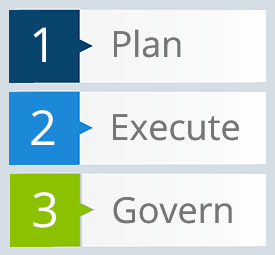So You Bought That Shiny New Sales Technology. Now What?
- After purchasing a new sales technology, you need to make sure you get the return on investment you expect
- SiriusDecisions has three essential phases of technology deployment: plan, execute and govern
- Taking a disciplined approach to each new sales technology will help sales operations ensure the purchase was worth the effort
Just like buying a new car, it’s time to hop in, drive off and enjoy the envious looks of your friends, right? Not so fast! Hopefully you went through a thorough decisionmaking process, including an assessment of your existing infrastructure, analysis of requirements, vendor evaluation and final selection. Now it’s time to make sure you get the return on investment and productivity increase that you expect.
SiriusDecisions has defined three essential phases of technology deployment:
 Plan. Technology adoption doesn’t just happen naturally. Processes must be defined or modified, users trained and leaders engaged. No matter how simple the technology appears, users will need to change behaviors and integrate the new technology into their workflow. In most cases, a pilot program is advisable to ensure the technology is understood and use cases are developed and documented. A thorough project plan includes activities, responsibilities (e.g. owner, contributor, influencer), deliverables, milestones and timelines for each phase of implementation.
Plan. Technology adoption doesn’t just happen naturally. Processes must be defined or modified, users trained and leaders engaged. No matter how simple the technology appears, users will need to change behaviors and integrate the new technology into their workflow. In most cases, a pilot program is advisable to ensure the technology is understood and use cases are developed and documented. A thorough project plan includes activities, responsibilities (e.g. owner, contributor, influencer), deliverables, milestones and timelines for each phase of implementation.- Execute. Once the project plan has been developed and approved by executive sponsors and resources have been allocated, it’s time for the execution phase. You’ll need to decide whether to go with the “big bang” approach, where the technology is rolled out to the entire sales organization at once, or whether a phased implementation is more appropriate. In either case, include in-process checkpoints to review the project workstream, identify barriers and address points of failure. Be sure that executives and stakeholders are prepared to demonstrate visible and active involvement in the project.
- Govern. Now that implementation is complete, it’s time to move on to the next project, right? Nope. To a certain extent, your job is never done. First, you need a formal close to the execution phase, with a post-project review that includes lessons learned, remaining tasks and assessment of benefits. Additional training, communication, change management and support may be required for the organization to fully adopt and embed the new technology and process. Governance activities may include standards for data management, service-level agreements, monitoring user behavior and reporting key metrics established during the project planning phase.
As we’ve previously noted, there are lots of new and emerging technologies on the market, with really cool features and functionality that can improve sales productivity. Unfortunately, the risk of failing to achieve the desired benefits are high – and the larger and more expensive the project, the greater the risk of failure. Taking a disciplined approach to each project will help sales operations ensure that the time, money and resources are worth the effort.
Come see Steve at SiriusDecisions Leadership Exchange later this month in San Diego – or at SiriusDecisions 2016 Summit in Nashville. View the track sessions and be sure to register before the early bird deadline expires … this Friday, February 12!
